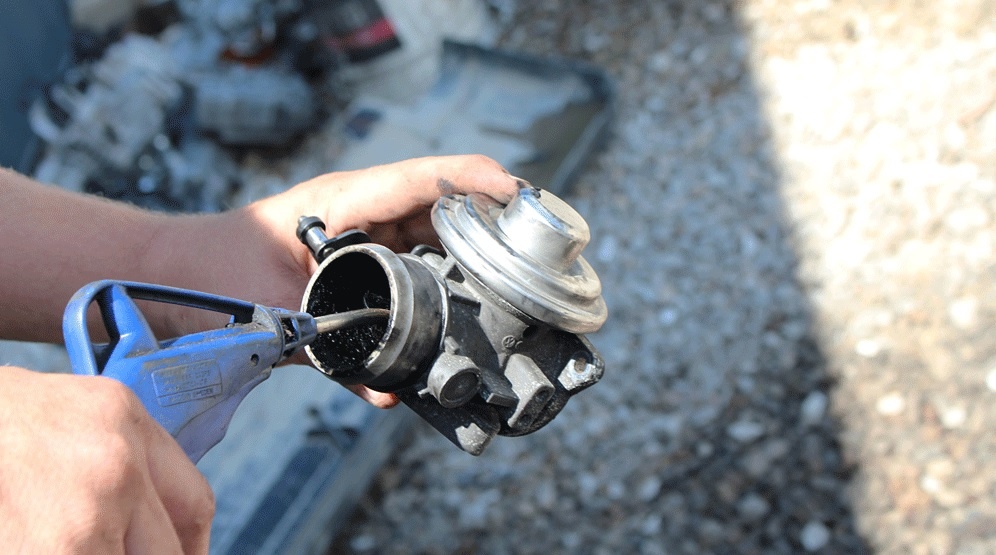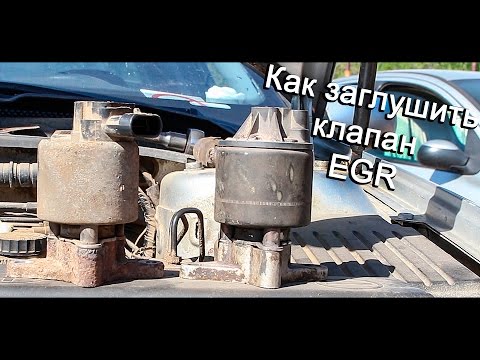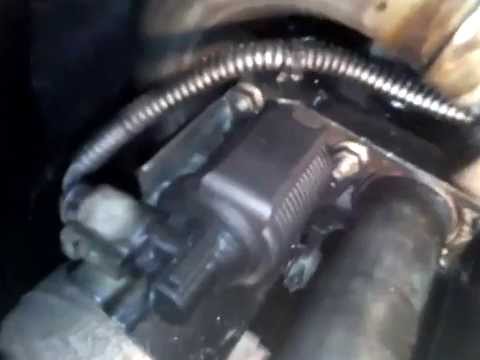
EGR valve
Content
EGR valve - the base part of the exhaust gas recirculation system (Exhaust Gas Recirculation). USR problem consists in reducing the level of formation of nitrogen oxides, which are the product of the work of the internal combustion engine. In order to lower the temperature, some of the exhaust gases are sent back to the internal combustion engine. Valves are installed on both gasoline and diesel engines, except for those that have a turbine.
From the point of view of ecology, the system performs a positive function, limiting the production of harmful substances. However, often the work of the USR is a source of numerous problems for motorists. The fact is that the EGR valve, as well as the intake manifold and working sensors, are covered with soot during the operation of the system, which causes unstable operation of the internal combustion engine. Therefore, many car owners resort not to cleaning or repair, but to jamming the entire system.
Where is the EGR valve
The mentioned device is exactly on the internal combustion engine of your car. In different models, the execution and location may be different, however, you need navigate by the location of the intake manifold. Usually a pipe comes from it. the valve can also be installed on the intake manifold, in the intake tract or on the throttle body. For example:
The EGR valve on the Ford Transit VI (diesel) is located in front of the engine, to the right of the oil dipstick
The EGR valve on the Chevrolet Lacetti is visible immediately when the hood is opened, it is located behind the ignition module
The EGR valve on the Opel Astra G is located under the upper right corner of the engine protective cover
also a few examples:
EGR valve on BMW E38
EGR valve for Ford Focus
EGR valve for Opel Omega
What is an EGR valve and types of its designs
Through the EGR valve, a certain amount of exhaust gases is sent to the intake manifold. then they are mixed with air and fuel, after which they enter the internal combustion engine cylinders along with the fuel mixture. The amount of gases is determined by a computer program embedded in the ECU. Sensors provide information for decision-making by the computer. Usually this is a coolant temperature sensor, absolute pressure sensor, air flow meter, throttle position sensor, intake manifold air temperature sensor, and others.
The EGR system and valve do not work continuously. So, they are not used when:
- idling (on a warmed-up internal combustion engine);
- cold internal combustion engine;
- fully open damper.
The first units used were pneumomechanical, that is, they were controlled using the vacuum of the intake manifold. However, over time they became electro-pneumaticand (standards EURO 2 and EURO 3) and completely electronic (EURO 4 and EURO 5 standards).
Types of EGR valves
If your vehicle is equipped with an electronic EGR system, it is controlled by an ECU. There are two types of digital EGR valves - with three or two holes. They open and close with the help of working solenoids. A device with three holes has seven levels of recirculation, a device with two has three levels. The most perfect valve is the one whose opening level is performed using a stepper electric motor. It provides smooth regulation of the gas flow. Some modern EGR systems have their own gas cooling unit. They also allow you to further reduce the level of waste nitrogen oxide.
The main causes of system failure and their consequences
Depressurization of the EGR valve - the most common failure of the EGR system. As a result, uncontrolled suction of air masses into the intake manifold occurs. If your car has an internal combustion engine with an air mass meter, this threatens to lean the fuel mixture. And when there is an airflow pressure sensor in the car, the fuel mixture will be re-enriched, due to which the pressure on the intake manifold will increase. If the internal combustion engine has both of the above sensors, then at idle it will receive a too enriched fuel mixture, and in other operating modes it will be lean.
Dirty valve is the second common problem. What to produce with it and how to clean it, we will analyze below. Please note that the slightest breakdown in the operation of the internal combustion engine can theoretically lead to a significant likelihood of contamination.
All breakdowns occur for one of the following reasons:
- Too much exhaust gas flows through the valve;
- too little exhaust gas passes through it;
- there was a depressurization of the valve body.
failure of the exhaust gas recirculation system can be caused by failure of the following parts:
- external branch pipes for supplying exhaust gases;
- EGR valve;
- thermal valve connecting the vacuum source and the EGR valve;
- solenoids that are controlled by the ECU;
- exhaust gas pressure converters.
Signs of a broken EGR valve
There are a number of signs indicating that problems are observed in the operation of the EGR valve. The main ones are:
- unstable operation of the internal combustion engine at idle;
- frequent stop of the internal combustion engine;
- misfiring;
- jerky movement of the car;
- a decrease in the vacuum on the intake manifold and, as a result, the operation of the internal combustion engine on an enriched fuel mixture;
- often in case of a serious breakdown in the operation of the exhaust gas recirculation valve - the car's electronic system signals a check light.
When diagnosing, error codes such as:
- P1403 - breakdown of the exhaust gas recirculation valve;
- P0400 - error in the exhaust gas recirculation system;
- P0401 - inefficiency of the exhaust gas recirculation system;
- P0403 - wire breakage inside the control valve of the exhaust gas recirculation system;
- P0404 - malfunction of the EGR control valve;
- P0171 - The fuel mixture is too lean.
How to check the EGR valve?
When checking, you need to inspection of the condition of the tubes, electrical wires, connectors and other components. If your vehicle has a pneumatic valve, you can use vacuum pump to activate it. For detailed diagnostics use electronic equipment, which will allow you to get the error code. With such a check, you need to know the technical parameters of the valve, in order to identify the discrepancy between the received and declared data.
The check is performed in the following sequence:
- Disconnect vacuum hoses.
- Purge the device without letting air pass through it.
- Disconnect the connector from the solenoid valve.
- Use the wires to supply power to the device from the battery.
- Blow out the valve while allowing air to pass through it.
When the check showed that the unit is not suitable for further operation, then the purchase and installation of a new one is required, but quite often, it is advised to simply drown the USR valve.
How to muffle the EGR valve?
If problems begin in the operation of the system or the EGR valve, then the simplest and cheapest solution would be to jam it.
It should be noted right away that one chip tuning is not enough. That is, turning off the valve control through the ECU does not solve all problems. This step only excludes system diagnostics, as a result of which the computer does not generate an error. However, the valve itself continues to work. Therefore, in addition it is necessary to make a mechanical exclusion of it from the operation of the ICE.
Some automakers include special valve plugs in the vehicle package. usually, this is a thick steel plate (up to 3 mm thick), shaped like a hole in the device. If you do not have such an original plug, you can make it yourself from metal of the appropriate thickness.
then remove the EGR valve. In some car models, the intake manifold must also be removed to do this. In parallel with this, clean its channels from contamination. then find the gasket that is installed at the valve attachment point. After that, replace it with the metal plug mentioned above. You can make it yourself or buy it at a car dealer.
During the assembly process, the standard gasket and the new plug are combined at the attachment point. It is necessary to tighten the structure with bolts carefully, since factory plugs are often fragile. After that, do not forget to disconnect the vacuum hoses and put plugs in them. At the end of the process, you need to make the mentioned chip tuning, that is, make an adjustment to the ECU firmware so that the computer does not show an error.

How to drown the USR

We jam the USR
What results will jamming the USR system lead to?
There are positive and negative sides. The positive ones include:
- soot does not accumulate in the collector;
- the dynamic characteristics of the car are increased;
- no need to change the EGR valve;
- not so frequent oil changes.
Negative sides:
- if there is a catalyst in the internal combustion engine, then it will fail faster;
- the breakdown indicator on the dashboard is triggered (check light);
- possible increase in fuel consumption;
- increased wear of the valve group (rarely).
EGR valve cleaning
Often, the EGR system can be restored by simply cleaning the device. More often than others, owners of Opel, Chevrolet Lacetti, Nissan, Peugeot cars encounter this.
RџSЂRё cleaning the EGR pneumatic valve need from soot clean the seat and stem. When cleaning the USR with a control solenoid valve, usually, the filter is being cleanedprotecting the vacuum system from contamination.
To clean, you need the following tools: open-end and spanner wrenches, two carburetor cleaners (foam and spray), a Phillips screwdriver, and valve lapping paste.

EGR valve cleaning
After you have found where the EGR valve is located, you need to fold the terminals from the battery, as well as the connector from it. then, using the wrench, unscrew the bolts that hold the valve, after which we take it out. The inside of the device must be soaked with a carburetor flush.
It is necessary to flush the channel in the manifold with a foam cleaner and a tube. The procedure must be performed within 5 ... 10 minutes. And repeat it up to 5 times. (depending on the level of contamination). At this time, the pre-soaked valve has rotted and is ready to be disassembled. To do this, unscrew the bolts and perform disassembly. Then, with the help of lapping paste, we grind the valve.
When lapping is done, you need to thoroughly wash everything, and scale, and paste. then you need to thoroughly dry and collect everything. also be sure to check the valve for leaks. This is done using kerosene, which is poured into one compartment. We wait for 5 minutes, so that the kerosene does not flow into another compartment, or on the reverse side, wetting does not appear. If this happens, then the valve is not sealed tight. To eliminate the breakdown, repeat the procedure described above. The assembly of the system is carried out in the reverse order.
EGR valve replacement
In some cases, namely, when the valve fails, it is necessary to replace it. Naturally, this procedure will have its own design features for each car model, however, in general terms, the algorithm will be approximately the same.
However, just before the replacement, several operations must be performed, namely, those related to the computer, resetting the information, so that the electronics “accept” the new device and do not give an error. So, you need to take the following steps:
- check the vacuum hoses of the exhaust gas recirculation system;
- check the operability of the USR sensor and the entire system;
- check the patency of the gas recirculation line;
- replace the EGR sensor;
- clean the valve stem from carbon deposits;
- remove the fault code in the ECU and test the operation of the new device.
As for the replacement of the mentioned device, we will give an example of its replacement on a Volkswagen Passat B6 car. The work algorithm will be as follows:
- Disconnect the valve seat position sensor connector.
- Loosen the clamps and remove the cooling hoses from the valve fittings.
- Unscrew the screws (two on each side) on the fastenings of the metal tubes intended for supplying and venting gases from / to the EGR valve.
- The valve body is attached to the internal combustion engine using a bracket with one power bolt and two M8 screws. Accordingly, you need to unscrew them, remove the old valve, install a new one in its place and tighten the screws back.
- Connect the valve to the ECU system, and then adapt it using software (it may be different).
As you can see, the procedure is simple, and usually, on all machines, it does not present great difficulties. If you ask for help at a service station, then the replacement procedure there costs about 4 ... 5 thousand rubles today, regardless of the brand of the car. As for the price of the EGR valve, it ranges from 1500 ... 2000 rubles and even more (depending on the brand of car).
Signs of a diesel engine failure
The EGR valve is installed not only on gasoline, but also on diesel engines (including turbocharged ones). And the most interesting thing in this vein is that during the operation of the device mentioned above, the problems described above for a gasoline engine for a diesel engine are much more relevant. First you need to turn to the differences in the operation of the device on diesel engines. So, here the valve opens at idle, providing about 50% clean air in the intake manifold. As the number of revolutions increases, it closes and closes already at full load on the internal combustion engine. When the motor is running in warm-up mode, the valve is also fully closed.
The problems are connected primarily with the fact that the quality of domestic diesel fuel, to put it mildly, leaves much to be desired. During the operation of a diesel internal combustion engine, it is the EGR valve, the intake manifold, and the sensors installed in the system that become contaminated. This may result in one or more of the following signs of “illness”:
- unstable operation of the internal combustion engine (jerks, floating idle speed);
- loss of dynamic characteristics (accelerates poorly, shows low dynamics even in low gears);
- increased fuel consumption;
- decrease in power;
- The internal combustion engine will work more “hard” (after all, the EGR valve in diesel engines is just what is needed to soften the operation of the motor).
Naturally, the listed phenomena may be signs of other malfunctions, however, it is still recommended to check the mentioned unit using computer diagnostics. And if necessary, clean, replace or simply muffle it.
there is also one way out - cleaning the intake manifold and the entire corresponding system (including the intercooler). Due to low-quality diesel fuel, the entire system becomes significantly contaminated over time, so the breakdowns described can be the result of just banal pollution, and will disappear after you perform the appropriate cleaning. This procedure is recommended to be performed at least once every two years, and preferably more often.
